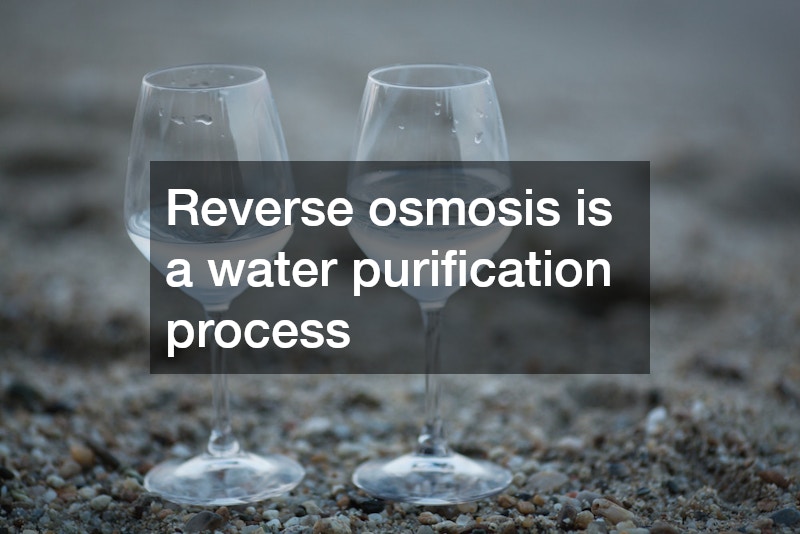Reverse osmosis is a water purification process that employs a semipermeable membrane to remove ions, molecules, and larger particles from drinking water. This technology has gained popularity as an effective method for providing clean and safe drinking water in both household and industrial settings. Imagine being able to remove impurities such as lead, chlorine, and other contaminants just by using a simple yet sophisticated system. The reverse osmosis process answers the growing concerns about water quality by ensuring that what you consume is pure and free from harmful substances.
In today’s world, where water pollution is a significant concern, reverse osmosis offers a reliable solution for water purification.
The central component of a reverse osmosis system is its membrane, which plays the crucial role of filtering out unwanted particles. The membrane is designed to allow water molecules to pass through while blocking larger impurities such as salt, bacteria, and organic material. By producing clean separation, reverse osmosis systems provide high-quality water that is both safe to drink and pleasant in taste. Additionally, reverse osmosis units often include multiple filtration stages to enhance efficiency and effectiveness. These stages can include pre-filters, post-filters, and sometimes additional treatments like UV sterilization or remineralization.
The inception of reverse osmosis can be traced back to the 1950s when it was developed as a method to desalinate seawater. Since then, it has evolved to become one of the most widely used water purification methods worldwide. Its versatility allows it to be used in diverse applications, from producing bottled water to purifying water in industrial processes. As technology continues to advance, reverse osmosis systems are becoming more energy-efficient, user-friendly, and affordable for consumers. The growing interest in sustainability and environmentally friendly solutions further bolsters the appeal of reverse osmosis, positioning it at the forefront of modern water purification technologies.
The Working Principle of Reverse Osmosis
At the heart of reverse osmosis is the concept of osmosis – a natural process where a solvent moves through a semipermeable membrane from a less concentrated solution to a more concentrated one. In reverse osmosis, this process is literally ‘reversed’ by applying pressure to the more concentrated solution, pushing the solvent, in this case, water, through the membrane and leaving impurities behind. The pressure required depends on the concentration of the contaminants in the feed water. Typically, higher salinity levels necessitate the use of higher pressures to achieve purification. This method’s brilliance lies in its ability to effectively remove up to 99% of dissolved salts and other impurities, ensuring the purity of the treated water.
In practical terms, the reverse osmosis system begins with water entering the system and passing through pre-filters, which remove larger particles that could damage the membrane. These particles often include sediment and chlorine, which can shorten the lifespan and reduce the effectiveness of the membrane if not removed beforehand. After pre-filtration, the pressurized water is forced through the semipermeable membrane, where the actual reverse osmosis process occurs. Clean water emerges on one side of the membrane as permeate, while the contaminants are flushed away as concentrate or brine on the other. This separation ensures that the output water is free from most impurities, delivering clean drinking water.
One of the notable aspects of reverse osmosis is its efficiency in removing a wide range of contaminants, making it superior to many other filtration methods. While systems like carbon filters rely on chemical adsorption to remove impurities, reverse osmosis physically separates water molecules from contaminants. This distinction allows it to tackle challenging impurities such as nitrates, arsenic, lead, fluoride, and much more. The process is particularly beneficial in locations where water supplies are compromised by agricultural runoff, industrial waste, or other pollutants. By customizing the stages and configurations of the system, reverse osmosis can be tailored to address specific water quality concerns, providing unparalleled purification results.
Benefits and Limitations of Reverse Osmosis
One of the most significant benefits of reverse osmosis is that it provides incredibly high-quality drinking water. The process effectively removes contaminants that could pose health risks, ensuring that consumers have access to clean and safe water. This makes it particularly valuable in areas where water sources are compromised by pollutants or poor infrastructure. Furthermore, reverse osmosis improves the taste and odor of water by eliminating things like chlorine and dissolved minerals, making it more palatable. The health benefits, convenience, and overall quality enhancement of water make reverse osmosis a compelling choice for households and businesses alike.
Despite its advantages, reverse osmosis does come with some limitations. One of the most noted is that the process can be wasteful; for every gallon of purified water, approximately two to three gallons are typically discarded as concentrate. This can be a concern in areas where water conservation is a priority. Moreover, reverse osmosis systems can remove beneficial minerals like calcium and magnesium, leaving the water tasting ‘flat’ to some individuals. To counter this, some systems incorporate remineralization filters to reintroduce these minerals and improve taste. Additionally, the upfront cost of installing a reverse osmosis system can be higher compared to other filtration options, though many deem the investment worthwhile for the long-term benefits.
It’s important to maintain reverse osmosis systems properly to ensure their optimal function and longevity. Regularly changing filters and cleaning the system are essential tasks to prevent membrane fouling and ensure efficient operation. Failure to maintain the system can lead to reduced effectiveness in filtration and a shorter lifespan of the system components. Despite these considerations, the benefits of reverse osmosis, particularly in providing safe, clean drinking water, often outweigh the challenges. For those committed to high-quality water purification, reverse osmosis represents a powerful tool in achieving superior water standards.
Applications of Reverse Osmosis
Reverse osmosis is utilized in a variety of applications beyond just providing clean drinking water. In industrial settings, it’s used to purify processed water, desalinate seawater, and treat wastewater for reuse. The technology is invaluable in industries such as food and beverage, pharmaceuticals, and electronics manufacturing, where high-purity water is essential. For example, in the food and beverage industry, reverse osmosis ensures ingredient water is free from impurities that could affect product quality. This broad applicability underscores the adaptability and effectiveness of reverse osmosis as a purification process.
In recent years, cities and municipalities have begun to adopt reverse osmosis technology on a larger scale. Faced with dwindling freshwater resources, many are turning to desalination using reverse osmosis to provide a sustainable water supply. This is especially critical in arid regions where groundwater and surface water sources are scarce. Reverse osmosis allows these areas to tap into the vast resources of seawater and transform it into drinkable water. As climate change and population growth continue to strain global water resources, the role of reverse osmosis in ensuring water security is increasingly recognized.
On a smaller scale, portable reverse osmosis systems are gaining popularity for personal use. These compact systems can be quickly deployed in settings ranging from remote campsites to emergency relief efforts, providing an immediate source of potable water. They serve adventurers, disaster relief workers, and military personnel who need reliable access to clean water in challenging conditions. The flexibility and reliability of reverse osmosis systems make them an indispensable technology in diverse scenarios where water quality matters most. As innovation continues, the potential of reverse osmosis to contribute to global water solutions remains promising.







